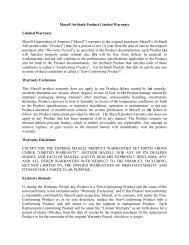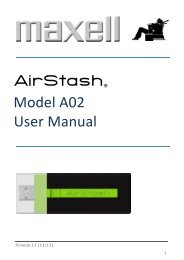Coin Type Lithium-ion Rechargeable Battery (CLB Battery ... - Maxell
Coin Type Lithium-ion Rechargeable Battery (CLB Battery ... - Maxell
Coin Type Lithium-ion Rechargeable Battery (CLB Battery ... - Maxell
You also want an ePaper? Increase the reach of your titles
YUMPU automatically turns print PDFs into web optimized ePapers that Google loves.
Li-<strong>ion</strong><br />
Secondary <strong>Battery</strong><br />
<strong>Coin</strong> <strong>Type</strong> <strong>Lithium</strong>-<strong>ion</strong> <strong>Rechargeable</strong> <strong>Battery</strong> (<strong>CLB</strong>)<br />
L<br />
i<br />
-<br />
i<br />
o<br />
n<br />
Notes for Designers<br />
Select the correct type of battery to match the operating condit<strong>ion</strong>s<br />
such as load current, etc.<br />
Charge condit<strong>ion</strong>s<br />
To get the most out of coin type lithium-<strong>ion</strong> batteries and use them<br />
safely, please use specified charge IC, protect<strong>ion</strong> IC and read the<br />
following requirements carefully: For different charge IC, protect<strong>ion</strong><br />
IC, consult your nearest <strong>Maxell</strong> dealer or distributor.<br />
Charge condit<strong>ion</strong>s<br />
Charge IC<br />
Charge method<br />
Charge voltage<br />
Standard charge current<br />
Max. charge current<br />
Charge temperature<br />
Protect<strong>ion</strong> condit<strong>ion</strong>s<br />
Protect<strong>ion</strong> IC<br />
Charge control flowchart (sample)<br />
Refer to the following flowchart when designing constant current and<br />
constant voltage battery chargers.<br />
Start charge<br />
Check battery connect<strong>ion</strong><br />
Check battery temperature<br />
Check battery voltage<br />
Passed<br />
Constant current, constant voltage charge<br />
• Current monitoring<br />
• Temperature monitoring<br />
• Time monitoring<br />
Passed<br />
Charge complet<strong>ion</strong><br />
Safety Instruct<strong>ion</strong>s<br />
Specified IC by <strong>Maxell</strong><br />
Constant current, constant voltage charge<br />
4.20±0.05V / cell<br />
35mA (0.5I tA)<br />
70mA (1.0I tA)<br />
0 to +45 deg. C<br />
Specified IC by <strong>Maxell</strong><br />
Failed<br />
Preliminary charge<br />
Failed<br />
Abnormal charge stop<br />
The battery contains organic solvents and other combustible<br />
materials. For this reason, improper handling of the battery could<br />
lead to distort<strong>ion</strong>, leakage*, overheating, explos<strong>ion</strong> or fire, causing<br />
bodily injury or equipment trouble. Please observe the following<br />
instruct<strong>ion</strong>s to prevent accidents. The following are general caut<strong>ion</strong>s<br />
and guidelines only and as such may not include every possible<br />
usage scenario. The manufacturer will not be liable for act<strong>ion</strong>s taken<br />
or accidents caused.<br />
(* Leakage is defined as the unintent<strong>ion</strong>al escape of a liquid from a<br />
battery.)<br />
Danger<br />
Do not dip or wet the battery in water, seawater, or other liquid.<br />
Otherwise the battery may be shorted, which may generate heat<br />
or cause damage.<br />
Do not put the battery into a fire. Otherwise, the electrolyte may<br />
burn or cause an explos<strong>ion</strong> or fire.<br />
Do not heat the battery. Otherwise heating the battery could<br />
increase the internal pressure, causing leakage, explos<strong>ion</strong>,<br />
overheating or fire.<br />
The battery has a predetermined polarity. If the battery will not<br />
connect well to the charger or equipment, do not try to connect<br />
the battery forcefully. Check the polarity first. If the battery is<br />
connected in reverse, it will be charged in reverse and may cause<br />
distort<strong>ion</strong>, leakage, overheating, explos<strong>ion</strong> or fire due to an<br />
abnormal chemical react<strong>ion</strong> during charge or an excessive current<br />
during discharge.<br />
Do not let the battery terminals (+ and -) come into contact with a<br />
wire or any metal (like a metal necklace or a hairpin) with which it<br />
is carried or stored. In such a case, the battery will be shorted and<br />
discharge excessive current, which may result in overheating,<br />
explos<strong>ion</strong>, fire or heat generat<strong>ion</strong> of the metal necklace or the<br />
hairpin.<br />
Do not apply any heavy impact to the battery, throw or drop it. Do<br />
not apply heavy load to the battery causing distort<strong>ion</strong>. Otherwise<br />
the battery may be shorted and result in leakage, overheating,<br />
explos<strong>ion</strong> or fire.<br />
Do not drive a nail into, hammer or stamp on the battery.<br />
Otherwise the battery may be shorted and result in destruct<strong>ion</strong>,<br />
distort<strong>ion</strong>, overheating, explos<strong>ion</strong> or fire.<br />
Do not weld a terminal or weld a wire to the body of the battery<br />
directly. The heat of welding or soldering could cause damage to<br />
the insulating material or the structure in the battery, leading to<br />
distort<strong>ion</strong>, leakage, overheating, explos<strong>ion</strong>, or fire. When soldering<br />
the battery directly to equipment, use the battery with tabs or<br />
leads and solder only the tips of the tabs or leads. Even then, the<br />
temperature of the soldering iron must be below 350 deg. C and<br />
the soldering time less than 5 seconds. Do not use a soldering<br />
bath, because the circuit board with battery attached could stop<br />
moving or the battery could drop into the bath. Moreover do not<br />
use excessive solder, because the solder could flow to unwanted<br />
port<strong>ion</strong>s of the board, leading to a short-circuit or charging of the<br />
battery by connecting to power source.<br />
Do not disassemble or alter the battery. Otherwise the insulating<br />
materials or the inside structure could be damaged, leading to<br />
distort<strong>ion</strong>, leakage, overheating, explos<strong>ion</strong> or fire.<br />
After long periods of storage without being used, the battery<br />
should be charged before it is used. Charge the battery every 6<br />
months to the level specified by the manufacturer, even if the<br />
battery is not used. Otherwise over-discharging the battery may<br />
cause an abnormal chemical react<strong>ion</strong> in the battery and result in<br />
the degradat<strong>ion</strong> of battery performance, such as a shortening of<br />
battery life, distort<strong>ion</strong>, leakage, overheating or fire.<br />
When charging the battery, always follow the charge condit<strong>ion</strong>s<br />
specified by the manufacturer. If the battery is charged under<br />
other condit<strong>ion</strong>s (a high temperature, a high voltage/current or an<br />
altered charger) not specified by the manufacturer, the battery<br />
may cause distort<strong>ion</strong>, overheating, explos<strong>ion</strong> or fire due to<br />
abnormal chemical react<strong>ion</strong>s.<br />
9
LITHIUM-ION RECHARGEABLE BATTERY<br />
Do not connect the battery directly to an electric outlet or cigarette<br />
lighter socket in a car. Applying a high voltage may generate an<br />
excessive current and cause an electric shock. In such a case, the<br />
battery may leak electrolyte, overheat, explode or cause fire.<br />
Do not use or leave the battery near fire, heaters, inside an<br />
automobile in hot weather or under strong sunshine. Such<br />
condit<strong>ion</strong>s of high temperature may damage the separator, and<br />
the battery may be shorted and result in overheating, explos<strong>ion</strong> or<br />
fire.<br />
Do not use the battery with any equipment or device other than<br />
those specified by the manufacturer. Any such practice may<br />
expose your equipment or device to an abnormal current, which<br />
may result in distort<strong>ion</strong>, overheating, explos<strong>ion</strong> or fire.<br />
Warnings<br />
Do not swallow. Always keep the battery out of the reach of<br />
infants and young children to prevent it from being swallowed. If<br />
swallowed, consult a physician immediately.<br />
Do not put the battery in a microwave oven or a pressure cooker.<br />
Sudden heat may damage the seal of the battery and may cause<br />
overheating, explos<strong>ion</strong> or fire.<br />
Do not use the battery together with a primary battery such as a<br />
dry battery or other battery of a different capacity, type and/or<br />
brand. In such a case, over-discharge during use or over-charge<br />
during charging may occur and abnormal chemical react<strong>ion</strong>s may<br />
cause heat generat<strong>ion</strong>, explos<strong>ion</strong> or fire from the battery.<br />
Design your equipment so that the end user cannot replace the<br />
battery by mistake. If you are an equipment manufacturer and<br />
need to replace the battery, please use a new one of the same<br />
type and same model as the existing one. Because this is a<br />
rechargeable battery, its characteristics are completely different<br />
from other primary batteries (e.g. coin type lithium manganese<br />
dioxide batteries: CR) or other secondary batteries (e.g. lithium<br />
manganese dioxide rechargeable batteries: ML) even though their<br />
shapes are alike. If a different battery is installed in the circuit in<br />
place of a <strong>CLB</strong> battery, gas could be generated or the primary<br />
battery could be short-circuited by charging. This could lead to<br />
distort<strong>ion</strong>, leakage, overheating, explos<strong>ion</strong> or fire.<br />
If you notice any unusual odor, heat, discolorat<strong>ion</strong>, deformat<strong>ion</strong> or<br />
any other characteristic apart from what you are used to while<br />
using, charging or storing the battery, then take it out of the<br />
equipment or charger, and avoid using it. Using it in such state<br />
may result in overheating, explos<strong>ion</strong> or fire.<br />
If the battery leaks or emits an unusual odor, remove it from the<br />
vicinity of any fire immediately. The electrolyte may catch fire,<br />
which may cause explos<strong>ion</strong> or fire.<br />
Do not let leaked electrolyte come into contact with the eyes. In<br />
the event of such contact, flush the eyes with plenty of water<br />
immediately and consult a doctor. Otherwise prolonged contact<br />
may cause serious injury.<br />
When charge does not stop in an expected period of time, stop<br />
charging. Otherwise the battery may cause overheating, explos<strong>ion</strong><br />
or fire.<br />
Caut<strong>ion</strong><br />
Use protect<strong>ion</strong> circuit in the applicat<strong>ion</strong> or a battery pack in order<br />
to prevent over-charge or over-discharge. Excess charge current<br />
or charge voltage may cause distort<strong>ion</strong>, leakage, overheating,<br />
explos<strong>ion</strong> or fire.<br />
Do not allow the battery electrodes to come in contact with your<br />
skin or fingers. Do not stick the battery on skin with adhesive tape<br />
or glue. Otherwise the moisture from your skin could cause a<br />
discharge of the battery, which could produce certain chemical<br />
substances causing you to receive chemical burns.<br />
Please be careful when installing the battery not to short-circuit it<br />
with metal port<strong>ion</strong>s of the equipment. Otherwise this could lead to<br />
distort<strong>ion</strong>, leakage, overheating, explos<strong>ion</strong> or fire.<br />
Keep the contact pressure at more than 2N for stable contact<br />
resistance. Otherwise the battery voltage may be lower than<br />
intended value due to poor contact condit<strong>ion</strong>.<br />
Do not use or leave the battery in a hot and highly humid place<br />
such as under the direct rays of the sun or in a car in hot weather.<br />
It may cause distort<strong>ion</strong>, leakage, overheating, explos<strong>ion</strong> or fire.<br />
Do not leave the battery or battery pack being charged after<br />
charge is finished. Otherwise it may cause the degradat<strong>ion</strong> of<br />
battery performance, such as a shortening of battery life.<br />
When the battery is expected not to be used for a long time, take<br />
the battery out of the equipment or device and store it in a less<br />
humid area.<br />
Do not use the battery in other than the following temperature<br />
ranges:<br />
Charge<br />
Discharge<br />
Storage (less than 30 days)<br />
Storage (less than 90 days)<br />
Warnings — Disposal<br />
The battery may be<br />
regulated by nat<strong>ion</strong>al or<br />
local regulat<strong>ion</strong>. Please<br />
follow the instruct<strong>ion</strong>s of<br />
proper regulat<strong>ion</strong>. As<br />
electric capacity is left in<br />
a discarded battery and it<br />
comes into contact with<br />
other metals, it could lead<br />
to distort<strong>ion</strong>, leakage,<br />
overheating, or explos<strong>ion</strong>,<br />
0 deg. C to +45 deg. C<br />
-20 deg. C to +60 deg. C<br />
-20 deg. C to +50 deg. C<br />
-20 deg. C to +35 deg. C<br />
Do not pile up or mix<br />
batteries.<br />
Enlarged view<br />
Electric current flows.<br />
These batteries generate heat.<br />
Tape<br />
–<br />
+<br />
<strong>Battery</strong><br />
(Example of<br />
battery insulat<strong>ion</strong>)<br />
so make sure to cover the (+) and (-) terminals with frict<strong>ion</strong> tape or<br />
some other insulator before disposal.<br />
L<br />
i<br />
-<br />
i<br />
o<br />
n<br />
10
<strong>CLB</strong>2032 <strong>Battery</strong> Unit<br />
Overview<br />
<strong>Maxell</strong> has developed a <strong>CLB</strong>2032 battery unit that includes four<br />
control funct<strong>ion</strong>s. This battery unit facilitates circuit design and can<br />
be installed quickly.<br />
Features<br />
Small <strong>CLB</strong>2032 battery unit that includes four different battery<br />
control funct<strong>ion</strong>s<br />
With a diameter of 20mm* and a height of 5mm, this small battery<br />
unit includes a charge control, protect<strong>ion</strong> funct<strong>ion</strong>, voltage regulator<br />
and low battery detector.<br />
Facilitates circuit design<br />
This <strong>CLB</strong>2032 battery unit has essential control circuits, enables<br />
easy circuit design and can be installed quickly.<br />
Charge control funct<strong>ion</strong><br />
The charging process is controlled automatically.<br />
Protect<strong>ion</strong> funct<strong>ion</strong><br />
Under-voltage, over-voltage and other limitat<strong>ion</strong>s are controlled<br />
automatically.<br />
Voltage regulat<strong>ion</strong> (opt<strong>ion</strong>al)<br />
Voltages of between 3.7V and 0.8V are available with the <strong>CLB</strong>2032<br />
battery unit’s DC/DC converter. This supports easier circuit design<br />
from a primary battery to a rechargeable battery by using existing<br />
circuit designs.<br />
Low battery detect<strong>ion</strong> (opt<strong>ion</strong>al)<br />
The <strong>CLB</strong>2032 battery unit can detect battery capacity after voltage<br />
convers<strong>ion</strong> by the DC/DC converter when output voltage drops to a<br />
certain point. This indicates that the battery needs recharging.<br />
Pin Configurat<strong>ion</strong><br />
<br />
<br />
Products<br />
<br />
<br />
1. Output (Vout)<br />
2. Input (+5V)<br />
3. Charge status (CHG)<br />
4. GND<br />
Model <br />
Dimens<strong>ion</strong>s* 1 Diameter* 2 <br />
(mm) <br />
1 <br />
<br />
<br />
<br />
<br />
<br />
<br />
<br />
3 <br />
<br />
*1 Dimens<strong>ion</strong>s and weight are for the product itself, but may vary<br />
depending on terminal specificat<strong>ion</strong>s and other factors.<br />
*2 Diameter excludes project<strong>ion</strong>.<br />
*3 Nominal capacity is according to the following condit<strong>ion</strong>s: Charge:<br />
0.5I tA / 4.2V (CCCV) / End current 2mA, Discharge: 0.2I tA / E.V. = 3.0V,<br />
Temperature 20 deg. C without DC/DC converter<br />
*4 2.7V means the under-voltage limit by the protect<strong>ion</strong> circuit<br />
*5 The DC/DC converter enables voltages of between 3.7V and 0.8V.<br />
3.0V is an example.<br />
• Data and dimens<strong>ion</strong>s are just reference values. For further details, please<br />
contact your nearest <strong>Maxell</strong> dealer or distributor.<br />
L<br />
i<br />
-<br />
i<br />
o<br />
n<br />
* Diameter excludes project<strong>ion</strong>.<br />
External Dimens<strong>ion</strong>s with Terminals and Wire Connectors (unit : mm)<br />
<strong>CLB</strong>2032 T1<br />
<strong>CLB</strong>2032 WK1<br />
<strong>CLB</strong>2032 BU PB<br />
<strong>CLB</strong>2032 BU CB<br />
5.0<br />
34<br />
Insulat<strong>ion</strong> sleeve<br />
21 21<br />
3.0<br />
ø20<br />
7.45<br />
20.2<br />
20<br />
4<br />
20<br />
4<br />
1.8<br />
Insulat<strong>ion</strong> sleeve<br />
4.0<br />
4.0<br />
4.4<br />
<br />
<br />
35<br />
Pin<br />
2<br />
3<br />
Insulat<strong>ion</strong> sleeve<br />
<br />
4.6 5<br />
4 2<br />
3 1<br />
Insulat<strong>ion</strong> sleeve<br />
5<br />
Lead wire<br />
11<br />
4 2<br />
3 1<br />
10<br />
Terminal<br />
Housing:<br />
Contact:<br />
Lead wire:<br />
DF13-2S-1.25C (Hirose)<br />
DF13-2630SCF (Hirose)<br />
AWG28 UL1571<br />
Pin configurat<strong>ion</strong><br />
1. Output (Vout)<br />
2. Input (+5V)<br />
3. Charge status (CHG)<br />
4. GND <br />
Terminal configurat<strong>ion</strong><br />
1. Output (Vout)<br />
2. Input (+5V)<br />
3. Charge status (CHG)<br />
4. GND <br />
12
Transportat<strong>ion</strong> of <strong>Lithium</strong> Batteries and <strong>Lithium</strong>-<strong>ion</strong> <strong>Rechargeable</strong> Batteries<br />
Dangerous Goods Transportat<strong>ion</strong> Regulat<strong>ion</strong>s for <strong>Lithium</strong> Metal Cells and Batteries (*)<br />
The following are revised transportat<strong>ion</strong> regulat<strong>ion</strong>s:<br />
• Internat<strong>ion</strong>al Civil Aviat<strong>ion</strong> Organizat<strong>ion</strong> (ICAO) Technical<br />
Instruct<strong>ion</strong>s (ICAO-TI), 2011-2012 edit<strong>ion</strong><br />
Effective date: January 1, 2011<br />
• Internat<strong>ion</strong>al Maritime Organizat<strong>ion</strong> (IMO) Internat<strong>ion</strong>al Maritime<br />
Dangerous Goods (IMDG) Code, 2010 edit<strong>ion</strong><br />
Effective date: January 1, 2012<br />
It is important that necessary arrangements be made so that all<br />
those concerned are thoroughly informed of the revis<strong>ion</strong>s.<br />
The minimum requirements necessary to transport as<br />
non-restricted goods are as follows;<br />
1) For a lithium metal or a lithium alloy cell, the lithium content must<br />
not be more than 1 g. For a lithium metal or lithium alloy battery,<br />
the aggregate lithium content must not be more than 2 g.<br />
2) Each cell or battery must be of the type proven to meet the<br />
requirement of each test in the UN Manual of Tests and Criteria,<br />
5th revised edit<strong>ion</strong>, Part III, sub-sect<strong>ion</strong> 38.3.<br />
3) A battery handling label must be displayed on each package. A<br />
telephone number must be printed on the label for addit<strong>ion</strong>al<br />
informat<strong>ion</strong>.<br />
4) Each consignment must be accompanied by a document for<br />
transport* 1 with an indicat<strong>ion</strong> that:<br />
• the package contains lithium metal cells or batteries;<br />
• the package must be handled with care and that a<br />
flammability hazard exists if the package is damaged;<br />
• special procedures should be followed in the event that the<br />
package is damaged, to include inspect<strong>ion</strong> and repackaging if<br />
necessary; and<br />
• a telephone number for addit<strong>ion</strong>al informat<strong>ion</strong>.<br />
* 1 For air transport, the words “Not Restricted” and the<br />
above informat<strong>ion</strong> must be indicated on the Air Waybill.<br />
5) Each package must be capable of withstanding a 1.2 m drop<br />
test.<br />
<strong>Maxell</strong> will offer the certificate of 1) and 2) as the need arises* 2 .<br />
Documentat<strong>ion</strong> for 3) and 4) need to be prepared by the<br />
customer. If our package is used for transport, we offer the<br />
certificate for 5) as the need arises* 2 .<br />
* 2 Please ask for the certificate through your normal purchase<br />
channels or sales representative.<br />
(*) <strong>Lithium</strong> metal cells and batteries:<br />
CR Cylindrical <strong>Type</strong> (<strong>Lithium</strong> Manganese Dioxide Batteries)<br />
Heat Resistant CR (<strong>Lithium</strong> Manganese Dioxide Batteries)<br />
CR <strong>Coin</strong> <strong>Type</strong> (<strong>Lithium</strong> Manganese Dioxide Batteries)<br />
ER (<strong>Lithium</strong> Th<strong>ion</strong>yl Chloride Batteries)<br />
ML <strong>Coin</strong> <strong>Type</strong> (<strong>Lithium</strong> Manganese Dioxide <strong>Rechargeable</strong> Batteries)<br />
TC Button <strong>Type</strong> (Titanium Carbon <strong>Lithium</strong> <strong>Rechargeable</strong> Batteries)<br />
Dangerous Goods Transportat<strong>ion</strong> Regulat<strong>ion</strong>s for <strong>Lithium</strong>-<strong>ion</strong> Cells and Batteries (*)<br />
The following are revised transportat<strong>ion</strong> regulat<strong>ion</strong>s:<br />
• Internat<strong>ion</strong>al Civil Aviat<strong>ion</strong> Organizat<strong>ion</strong> (ICAO) Technical<br />
Instruct<strong>ion</strong>s (ICAO-TI), 2011-2012 edit<strong>ion</strong><br />
Effective date: January 1, 2011<br />
• Internat<strong>ion</strong>al Maritime Organizat<strong>ion</strong> (IMO) Internat<strong>ion</strong>al Maritime<br />
Dangerous Goods (IMDG) Code, 2010 edit<strong>ion</strong><br />
Effective date: January 1, 2012<br />
It is important that necessary arrangements be made so that all<br />
those concerned are thoroughly informed of the revis<strong>ion</strong>s.<br />
The minimum requirements necessary to transport as<br />
non-restricted goods are as follows;<br />
1) For lithium-<strong>ion</strong> cells, the Watt-hour rating is not more than 20 Wh.<br />
For lithium-<strong>ion</strong> batteries, the Watt-hour rating is not more than<br />
100 Wh. The Watt-hour rating must be marked on the outside of<br />
the battery case except for those manufactured before January<br />
1, 2009.<br />
2) Each cell or battery is of the type proven to meet the<br />
requirement of each test in the UN Manual of Tests and Criteria,<br />
5th revised edit<strong>ion</strong>, Part III, sub-sect<strong>ion</strong> 38.3.<br />
3) A battery handling label must be displayed on each package. A<br />
telephone number must be printed on the label for addit<strong>ion</strong>al<br />
informat<strong>ion</strong>.<br />
4) Each consignment must be accompanied by a document for<br />
transport* 1 with an indicat<strong>ion</strong> that:<br />
• the package contains lithium-<strong>ion</strong> cells or batteries;<br />
• the package must be handled with care and that a<br />
flammability hazard exists if the package is damaged;<br />
• special procedures should be followed in the event the<br />
package is damaged, to include inspect<strong>ion</strong> and repackaging if<br />
necessary; and<br />
• a telephone number for addit<strong>ion</strong>al informat<strong>ion</strong>.<br />
* 1 For air transport, the words “Not Restricted” and the<br />
above informat<strong>ion</strong> must be indicated on the Air Waybill.<br />
5) Each package must be capable of withstanding a 1.2 m drop<br />
test.<br />
<strong>Maxell</strong> will offer the certificate of 1) and 2) as the need arises* 2 .<br />
Documentat<strong>ion</strong> for 3) and 4) need to be prepared by the customer.<br />
If our package is used for transport, we offer the certificate for 5)<br />
as the need arises* 2 .<br />
* 2 Please ask for the certificate through your normal purchase<br />
channels or sales representative.<br />
(*) <strong>Lithium</strong>-<strong>ion</strong> cells and batteries:<br />
Prismatic lithium-<strong>ion</strong> rechargeable cells and batteries<br />
Cylindrical lithium-<strong>ion</strong> rechargeable cells and batteries<br />
Laminated type lithium-<strong>ion</strong> rechargeable cells and batteries<br />
<strong>Coin</strong> type lithium-<strong>ion</strong> rechargeable cells and batteries<br />
NOTE: For laminated type lithium-<strong>ion</strong> rechargeable cells, the watt-hour rating is<br />
over 20 Wh and therefore the cells must be shipped as class 9 dangerous<br />
goods. For more informat<strong>ion</strong>, see the latest vers<strong>ion</strong> of ICAO TI, IATA DGR and<br />
IMDG Code.<br />
51
Catalog contents accurate as of February 2012.<br />
Data and dimens<strong>ion</strong>s are just reference values.<br />
Contents on this catalog are subject to change without notice.<br />
Committed to the highest quality assurance management standards as well as responsibility to the environment,<br />
<strong>Maxell</strong>'s Batteries product<strong>ion</strong> facilities are accredited with both ISO 9001 and ISO 14001 certificat<strong>ion</strong>s.


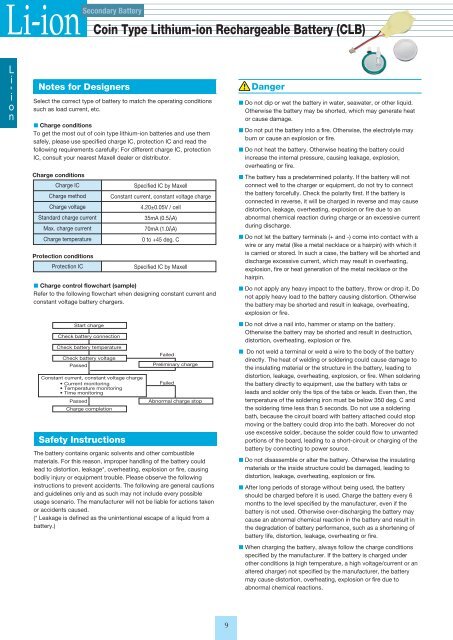

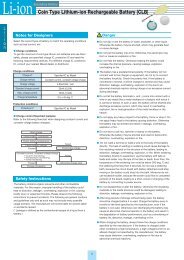


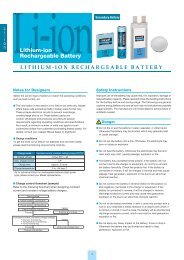
![CLB 电池å•元目录[PDF 1.07MB] - Maxell](https://img.yumpu.com/33415090/1/190x257/clb-aaauaaa-aaaoaaaaaaraa-1-2-aopdf-107mb-maxell.jpg?quality=85)
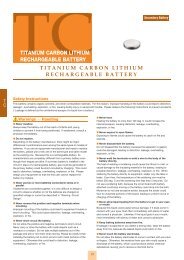
![Cylindrical CR catalog [PDF 1.61MB] - Maxell](https://img.yumpu.com/32837016/1/184x260/cylindrical-cr-catalog-pdf-161mb-maxell.jpg?quality=85)
